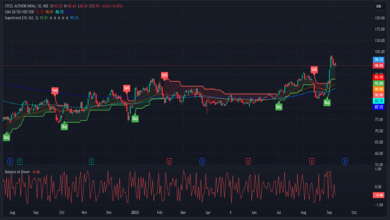South Indian Bank Share Price: A Comprehensive Guide to Investment and Market Trends

South Indian Bank, one of the prominent private sector banks in India, has garnered significant attention from investors. With its presence in various financial services, understanding the trends surrounding the South Indian Bank share price is essential for potential investors and market analysts. This blog explores everything you need to know about the share price, its influencing factors, investment strategies, and future outlook.
What Affects South Indian Bank Share Price?
The South Indian Bank share price is influenced by a variety of factors, both internal and external. These factors include macroeconomic indicators, interest rate changes, government policies, and the bank’s own financial performance. Any significant change in these areas can cause fluctuations in the share price. For example, a rise in interest rates might increase the cost of borrowing, impacting the bank’s profitability and thereby affecting the South Indian Bank share price.
Additionally, factors such as inflation rates, RBI’s monetary policies, and the overall market sentiment toward the banking sector can play a pivotal role in shaping the South Indian Bank share price. Investors often need to monitor these external variables to make informed decisions about their investments.
South Indian Bank’s Financial Performance
The financial performance of any bank is crucial in determining its stock value. The South Indian Bank share price is no different, being highly responsive to its quarterly and annual financial reports. When South Indian Bank reports an increase in net profit, positive asset quality, or expanding customer base, it often reflects positively on the South Indian Bank share price. On the other hand, if the bank faces challenges such as a rise in non-performing assets (NPAs) or a decline in profitability, it could result in a drop in its share price.
Investors are always keen to keep an eye on earnings reports, as they provide valuable insights into how well the bank is performing. This, in turn, plays a major role in the fluctuation of the South Indian Bank share price.
Stock Market Trends and South Indian Bank Share Price
Like any other stock, the South Indian Bank share price is also subject to broader market trends. During bullish market conditions, when investors are optimistic, share prices tend to rise across the board, and South Indian Bank is no exception. Conversely, bearish market conditions can drag the share price down, regardless of the bank’s individual performance.
External factors such as global financial markets, foreign investor sentiments, and geopolitical tensions also have indirect effects on the South Indian Bank share price. Understanding these market trends can help investors make more informed decisions when investing in South Indian Bank’s shares.
Investment Strategies for South Indian Bank Shares
Investing in South Indian Bank shares requires a well-thought-out strategy. One common approach is value investing, where investors look at the intrinsic value of the stock relative to its market price. If the South Indian Bank share price is deemed undervalued compared to its fundamental worth, it might be a good time to buy.
Another strategy is momentum investing, where investors capitalize on the upward or downward trends of the stock price. When the South Indian Bank share price is on an upward trajectory due to positive news or market sentiment, some investors might decide to ride the trend until it peaks before selling off.
Additionally, dividend investing could be a strategy, where investors focus on the dividends provided by South Indian Bank as a way of generating consistent income, while also benefiting from the appreciation in the share price.
Long-Term Outlook for South Indian Bank Share Price
When analyzing the long-term outlook for the South Indian Bank share price, several factors come into play, including the bank’s future growth prospects, expansion plans, and its ability to adapt to technological advancements in the banking industry. South Indian Bank’s digital transformation and its focus on improving customer experience can potentially have a positive impact on its share price in the future.
Moreover, the bank’s efforts to reduce non-performing assets, enhance capital adequacy, and expand its loan book can lead to improved financial performance. If these factors align favorably, the South Indian Bank share price may see significant appreciation over the long term.
However, it is also important to consider the competitive landscape. The Indian banking sector is highly competitive, with major players like HDFC Bank, ICICI Bank, and State Bank of India dominating the market. South Indian Bank’s ability to carve out its niche and remain profitable amidst this competition will significantly influence its share price.
Risk Factors to Consider When Investing in South Indian Bank Shares
While the potential for growth in South Indian Bank’s share price exists, there are several risks that investors must be mindful of. One major risk is the volatility of the South Indian Bank share price, which can fluctuate due to economic downturns, regulatory changes, or any financial instability within the bank.
Another risk is the growing competition in the banking sector, which can pressure South Indian Bank to innovate and maintain profitability. Failure to do so could negatively impact its share price. Additionally, macroeconomic factors like rising inflation or tightening monetary policies could adversely affect the bank’s lending rates and profitability, thus influencing the South Indian Bank share price.
Investors must also consider geopolitical risks and global market uncertainties that can lead to volatile financial markets, affecting banking stocks like South Indian Bank. These risk factors should be weighed before making any investment decisions.
How to Stay Updated on South Indian Bank Share Price
To make the most out of your investments in South Indian Bank, staying informed is key. Regularly tracking the South Indian Bank share price through financial news, stock market apps, and banking reports is essential. Investors can use platforms like the Bombay Stock Exchange (BSE) and the National Stock Exchange (NSE) to follow real-time updates on the share price.
Moreover, subscribing to newsletters from financial websites and utilizing stock market analysis tools can help in analyzing the South Indian Bank share price trends. Engaging with market experts and financial advisors will also provide valuable insights into the potential movements in the share price.
Conclusion
In conclusion, the South Indian Bank share price is influenced by a wide range of factors including financial performance, market trends, economic conditions, and investor sentiment. Whether you are a seasoned investor or someone new to the market, understanding these aspects is critical for making sound investment decisions. With proper analysis and a well-planned investment strategy, you can potentially benefit from investing in South Indian Bank shares.
FAQs
- What is the current South Indian Bank share price? The South Indian Bank share price fluctuates daily based on market conditions. It’s advisable to check live updates on financial platforms like NSE or BSE.
- What factors influence South Indian Bank share price? The South Indian Bank share price is influenced by the bank’s financial performance, economic conditions, market trends, and investor sentiment.
- Is South Indian Bank a good stock to invest in for the long term? The long-term outlook of the South Indian Bank share price depends on the bank’s growth, management efficiency, and market conditions. Proper research is needed before making long-term investments.
- How can I track South Indian Bank share price? You can track the South Indian Bank share price on financial platforms like BSE, NSE, and various stock market apps for real-time updates.
- What are the risks of investing in South Indian Bank shares? Investing in South Indian Bank shares involves risks such as market volatility, competition in the banking sector, and economic downturns that could affect the share price.







